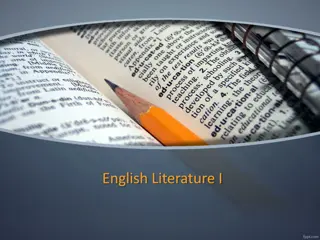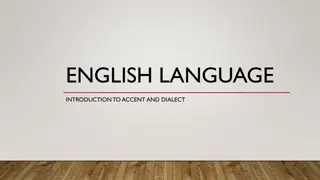Normative Accents in English: RP and GenAm Overview
Normative English accents, Received Pronunciation (RP) and General American (GenAm), serve as reference points for English learners and speakers globally. RP is associated with the British elite and institutions, while GenAm represents a regionless form of American pronunciation. Both accents, spoken by minorities, carry social prestige and widespread intelligibility. Learn about their history, characteristics, and evolving nature within the English language landscape.
Download Presentation

Please find below an Image/Link to download the presentation.
The content on the website is provided AS IS for your information and personal use only. It may not be sold, licensed, or shared on other websites without obtaining consent from the author.If you encounter any issues during the download, it is possible that the publisher has removed the file from their server.
You are allowed to download the files provided on this website for personal or commercial use, subject to the condition that they are used lawfully. All files are the property of their respective owners.
The content on the website is provided AS IS for your information and personal use only. It may not be sold, licensed, or shared on other websites without obtaining consent from the author.
E N D
Presentation Transcript
Topics in Phonetics & Phonology John Corbett: USP-CAPES International Fellow Session 3: Normative accents: RP and GenAm
1. Introduction: Review of IPA & lexical sets 2. Review: Transcribing connected speech 3. Accents of English 1: Reference accents (RP and GenAm) Course structure 4. Revisiting English as a lingua franca 5. Accents of English 2: Two American accents 6. Accents of English 3: Two British Accents 7. Accents of English 4: Accents of World English 8. Accents of English 5: Brazilian English accents
9. Acoustic phonetics: Using WASP 10. Rhythms of English: Poetic metre 11. Rhythms of English: Rhythm in speech Course structure 12. Discourse intonation 1 13. Discourse intonation 2 14. Course review
RP and GenAm as normative accents: What is their history? Why are they normative? This session What are their indexical features? Can you distinguish an RP from a GenAmspeaker? Can you switch from RP to GenAm?
A normative accent is used as a point of reference for users, whether overseas learners or native speakers. For English the normative accents are Received Pronunciation (for the UK, Australia, New Zealand, South Africa) and GenAmfor the USA. RP is associated with the elite class ( Queen s English), education ( Oxford English ) and serious institutional usages ( BBC English ). What is a normative accent GenAmis a disputed term, sometimes used to refer to a relatively regionlessform of American pronunciation outsideNew England, New York and the Southern States. Both RP and GenAmare spoken by only a minority of native speakers, but their social prestige and regionally unmarked nature makes them widely intelligible and attractive as learner models. Though they are relatively unmarked for region, there are varieties of RP and GenAmand they do change over time!
Developed as a model for middle-class speech in England, deriving probably from the accent spoken at court and by scholars at Oxford and Cambridge. Disseminated by the elite public school system (ieprivate education). By the early 20thcentury it was recognisable enough to be codified by the phonetician, Daniel Jones, who called it Public School Pronunciation and then RP . RP in context It was adopted by the BBC when it was established in the 1920s and radio, and then television, promoted its wider dissemination and added to its prestige. It was the standard model of BBC pronunciation until the 1960s. Still used as the basis for English language textbooks produced in the UK for international learners.
1. RP is non-rhotic, ie, /r/ is only pronounced preceding a vowel. It is not articulated before consonants or word-finally. RP: Indexical features car /k :/ bar /b :/ rare /re / /r/ is used to link vowels in sequences like /re r i:glz/ (rare eagles) Intrusive /r/ is heard in sequences like /l r n d / (law and order)
2. Vowel contrasts: LOT versus THOUGHT / / / / TRAP versus BATH RP: Indexical features / / / / FOOT versus GOOSE / / /u:/ short long lax tense
Can you group the following words as short or long? Short: LOT/TRAP/FOOT Long: THOUGHT/BATH/GOOSE Short or long? Lax or tense? pull sock hand palm sauce father taught back broad possible good shoot put huge view cancel quality ask
Can you group the following words as short or long? Short/lax: LOT/TRAP/FOOT Long/tense: THOUGHT/BATH/GOOSE Short or long? Lax or tense? pull sock hand palm sauce father taught back broad possible good shoot put huge view cancel quality ask
Can you speak RP?
http://accent.gmu.edu/searchsaa.php?function=detail&speakerid=70 Listening to RP
GenAm coined by George P. Krapp (1924) in The English Language in America. The validity of the term is disputed. Accepted by JC Wells in Accents of English (1982) as a form of English pronunciation spoken by Americans outside the Eastern and Southern States of the USA. GenAm in context Like RP, associated with broadcasting ( Network Standard ) Used in American textbooks as a model for English pronunciation for second language learners.
The term General American distinguishes the rhotic American accents from the non-rhotic varieties of the Eastern and Southern States. USA: Speech Areas
A more detailed representation of US speech areas USA: Speech Areas
GenAm is rhotic - /r/ is pronounced in all contexts, though the /r/ articulation might be an r-coloured vowel (eg / /) RP /k :/ RP /b :/ RP /re / car bar rare GenAm /k r/ GenAm /b r/ GenAm /r r/ Indexical features of GenAm GenAm tends to reduce the number of vowels in the context /___r/. /ir ~ r/ merge as / r/ /e r ~ r ~ r/ merge as / r/ / r/ (START, LOT) / r ~ or/ merge as / r / / r ~ r/ merge as / / near, spirit fairy, ferry, marry bar, sorry war, bore, orange current, furry
The short monophthongs / / may become centring diphthongs when stressed and preceding a final voiced consonant, eg /b b/ He s wearing a bib! Let s go to bed! Your so good! Give me a rub! /b d/ /g d/ /r b/ GenAm vowels: tendency to diphthongize Before / / and / /, certain vowels may diphthongize towards / /, e.g. [m ] /spl / /p / /w / Before final /l/ there may be diphthongization of /i/ and /u/ e.g. [fi ] [ri ] [ru ] [sku ]
Other consonantal features of GenAm Yod-dropping: /tun/ /nu/ /duk/ /dud/ Hypercorrection /njun/ /b / voiced alveolar tap T-voicing:
Pronouncing GenAm (Utah)
http://accent.gmu.edu/searchsaa.php?function=detail&speakerid=124 Listening to GenAm (Utah)
Thisweeks moodlequiz Comparing RP andGenAm
Revisiting ELF with Daniel Ferraz Next week























